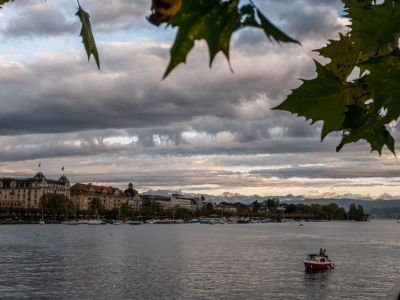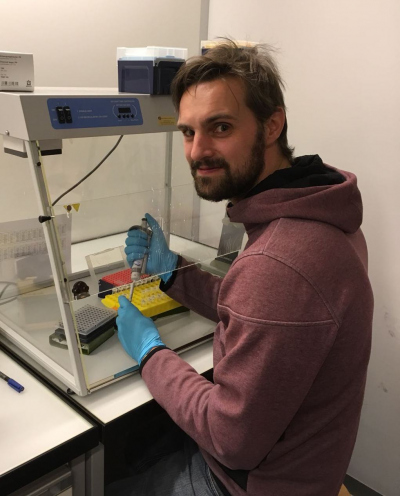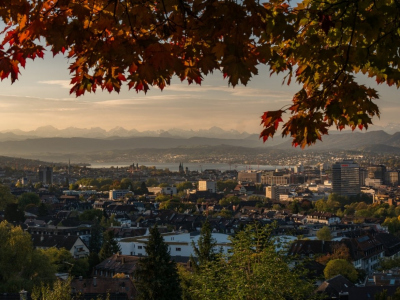- Graduate School GLOMAR
- PhD student reports
- Research Placements
- Bernhard Viehweger
Bernhard Viehweger
Report of GLOMAR PhD student Bernhard Viehweger about his research stay at the ETH Zürich, Schwitzerland from 1 October to 22 December 2017
In my PhD project I study the size and extent of the marine sedimentary deep biosphere. Hereby, I focus on specific bacteria, Firmicutes, which have the ability to form endospores. Endospore formation is a survival strategy against various environmental stressors, such as high temperature and low-nutrient availability, which are key factors for limiting life in the subseafloor environment. Bacterial endospores are suspected to be potentially important players in the deep hot biosphere but often overlooked by traditional fluorescent cell counts or DNA-based methods, due to their highly resistant nature. For quantification I use a specific geochemical tracer for intact endospores and specialized microbiological molecular methods for endospore-forming Firmicutes. The latter is the reason I got in contact with my collaborator Prof. Dr. Mark Lever from the Environmental Microbiology Group at the ETH Zürich. He is an expert in marine molecular microbiology and is also involved in the ongoing data analysis of very challenging, low-biomass environment of the South Pacific Gyre, sampled during IODP Expedition 329.
Mark Lever was recommended to me as a suitable candidate for my thesis committee and also collaborator at the beginning of my PhD. I did not know him personally, but he already collaborated with several of my present and past colleagues and students. After joining my thesis committee we were regularly in contact in 2016 before my onboard participation of IODP Expedition 370, to define sampling strategies and plan the collaboration afterwards. In spring 2017 I visited the ETH Zürich for the first time for nearly two month to implement the specific protocols needed for extracting and quantifying endospores and endospore-forming Firmicutes from marine sediments. They were developed for lake sediments in Switzerland but so far not applied to marine, subseafloor environments.
After the successful first stay I started right away planning the next one. The work plan for this research stay was to confirm the modified protocols with some less challenging test samples, then move on to more difficult samples of the Guaymas Basin and finally to work on the very challenging low-biomass samples of the Nankai Trough from IODP Expedition 370. Though both sites are very different age wise, they are both strongly affected by high temperature gradients, therefore a perfect natural lab to study temperature effects on endospore-forming Firmicutes abundance and diversity.
As it turned out, it was not enough time to finish everything planned initially, but some milestones were reached. As time got shorter towards the end of my stay we decided to focus on obtaining a complete dataset from the most promising samples from the Guaymas Basin. Unfortunately this means that I were not able to start working on the IODP Expedition 370 samples. Data analysis for the Guaymas Basin samples will follow the coming months and I hope I will end up with one of the key data sets for one of my publications.
Nevertheless, the research stay at ETH Zürich also offered other, equally valuable experiences for me personally. I was able to meet up again with one of the PhD students from Mark Levers Environmental Microbiology Group which whom I sailed on IODP Expedition 370. We also used the time to discuss QA/QC data from the expedition and work on an extended report for the upcoming second post-cruise meeting. I was also able to meet up with a former PhD student from my group in Bremen which now works as a Post-Doc in Mark’s group and reunite with some of his other students I got to know in spring and renew our friendships. Due to the long stay I also had time to get to know some new students and many of the members of the large Environmental Chemistry group of Prof. Dr. Kristopher McNeill at the ETH.
I am very grateful to GLOMAR for a large part of the funding, which enabled me to expand the research stay to full three month. Also I want to thank Mark Lever and is group for hosting me in such an excellent way and also for the financial support for lab consumables and analysis.
To conclude I want to say that I enjoyed my stay very much and it was wonderful to experience the atmosphere of such a traditional and internationally renowned university first hand and would like to encourage every PhD student to go on a research stay abroad.





